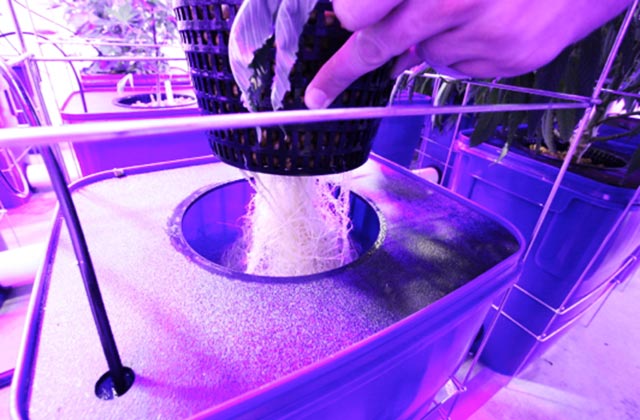Healthy Cannabis Roots Equal Bigger Marijuana Yields
One of the single most important factors of how well a marijuana plant will grow, and how much it can yield, is the health and strength of its root system. Below the surface of your growing medium, the root mass is comprised of a tangled web of roots that store sugars and starches (cannabis plant food) and transport needed minerals to the plant. The marijuana plants roots are covered in millions of small hairs that absorb water and minerals from the surrounding root zone.
This root system sends minerals up through the body of the plant to leaves for use during photosynthesis, which in turn makes the starches and sugars the plant uses for food and energy. The bigger and more extensive the root system is, the bigger the plant will grow.
In the root zone, moisture levels, temperature and oxygen directly affect growth. It is very important to remember that roots breath in oxygen, while the rest of the plant uses carbon dioxide (CO2). When growing indoors and using potted containers, the best containers to house your plants are those which are the most breathable, or permeable by air, so that oxygen can easily get into the root zone. If you grow outside, aerating your soil or grow medium by churning or tilling once every few weeks is also a good idea.
How Marijuana Roots Work
When starch is made via photosynthesis in the top portions of the plant, any excess plant food is sent back down to the root system for storage. The more energy the roots have stored up, the more nutrients they can send up to the leaves to be used in photosynthesis to make more food. It’s a cycle that, when all things are going well, can lead to excessive plant growth. When the plants are properly trained (via trellising or pruning), this growth or energy can be directed towards flower and resin (trichome) production.
In the root zone, the quality of medium is also very important for these same reasons. The less energy the roots have to spend, the more they can use that energy to grow themselves and the plant above. The root zone is also where most of the plant’s water is taken into the plant. And 99 percent of this water is transpired through the leaves up top.
Mediums that are airy and retain a lot of moisture are most ideal. Soil and soilless mixtures (such as peat or sphagnum-based) are also recommended as they offer excellent “buffering” for the delicate roots, which helps prevent burn from nutrient feedings and allows them to more effectively absorb the vital minerals needed to make sugars and starches internally.
Four Tips for Healthy Roots

A Deep Water Culture (DWC) system produces massive root structure.
1. Oxygen
Roots use oxygen to convert stored starch to energy so make sure air can permeate. This energy is used to send nutrients up the plant, which in turn creates more starches. The circle of life begins here.
2. Temperature
Roots grow mostly at night when the top portion of the plant has shut down. And they function most efficiently when they are warm. Roots in a dark, warm place develop rapidly and create good structure in the root zone. Dark period temps of 75–78 F are ideal.
3. Structure
If possible, do not let roots become root-bound. If they cannot be allowed to advance, allow them to prune themselves via exposure to air. Some containers offer specialized coatings to stop roots from growing and strangling themselves while others have holes lining the sides.
4. More Air
The top third of the root zone containers specialized roots that breath air; The bottom-third are “water roots,” which absorb H2O. Be careful not to over-water plants, especially near the top of the root zone, otherwise you may drown them. Stagnant water can easily kill a plant. Your roots should always be bright white and crisp.
The post Healthy Cannabis Roots Equal Bigger Marijuana Yields appeared first on High Times.


